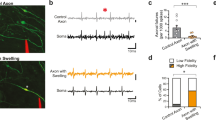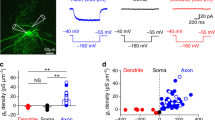Abstract
Knowledge of the site of action potential initiation is essential for understanding how synaptic input is converted into neuronal output. Previous studies have shown that the lowest-threshold site for initiation of action potentials is in the axon. Here we use recordings from visualized rat cerebellar Purkinje cell axons to localize the site of initiation to a well-defined anatomical structure: the first node of Ranvier, which normally forms at the first axonal branch point.
This is a preview of subscription content, access via your institution
Access options
Subscribe to this journal
Receive 12 print issues and online access
$209.00 per year
only $17.42 per issue
Buy this article
- Purchase on Springer Link
- Instant access to full article PDF
Prices may be subject to local taxes which are calculated during checkout



Similar content being viewed by others
References
Stuart, G.J. & Sakmann, B. Nature 367, 69–72 (1994).
Stuart, G. & Häusser, M. Neuron 13, 703–712 (1994).
Häusser, M., Stuart, G., Racca, C. & Sakmann, B. Neuron 15, 637–647 (1995).
Colbert, C.M. & Johnston, D. J. Neurosci. 16, 6676–6686 (1996).
Stuart, G., Schiller, J. & Sakmann, B. J. Physiol. (Lond.) 505, 617–632 (1997).
Armstrong, D.M. & Rawson, J.A. J. Physiol. (Lond.) 289, 425–448 (1979).
Gianola, S., Savio, T., Schwab, M.E. & Rossi, F. J. Neurosci. 23, 4613–4624 (2003).
Zhou, D. et al. J. Cell Biol. 143, 1295–1304 (1998).
Coombs, J.S., Curtis, D.R. & Eccles, J.C. J. Physiol. (Lond.) 139, 232–249 (1957).
Colbert, C.M. & Pan, E. Nat. Neurosci. 5, 533–538 (2002).
Mainen, Z.F., Joerges, J., Huguenard, J.R. & Sejnowski, T.J. Neuron 15, 1427–1439 (1995).
Häusser, M., Major, G. & Stuart, G.J. Science 291, 138–141 (2001).
Attwell, D. & Laughlin, S.B. J. Cereb. Blood Flow Metab. 21, 1133–1145 (2001).
Somogyi, P., Tamas, G., Lujan, R. & Buhl, E.H. Brain Res. Brain Res. Rev. 26, 113–135 (1998).
Eccles, J.C., Ito, M. & Szentágothai, J. The Cerebellum as a Neuronal Machine (Springer-Verlag, Berlin, 1967).
Acknowledgements
We thank J. T. Davie, J.J.B. Jack, C. Racca and A. Roth for helpful comments; V. Bennett for the ankyrin-G antibody; and A. Gidon, L. Ramakrishnan, E. Rancz, and A. Roth for help with reconstructions and videos. This work was supported by grants from the Wellcome Trust, European Commission, and the Gatsby Foundation. M.L. is a Long-Term Fellow of the Human Frontier Science Program, and T.B. was funded by the Wellcome Trust 4-year PhD Programme in Neuroscience.
Author information
Authors and Affiliations
Corresponding author
Ethics declarations
Competing interests
The authors declare no competing financial interests.
Supplementary information
Supplementary Video 1
Initiation of action potentials in the Purkinje cell model. Movie showing spatial spread of the action potential during spontaneous firing in the Purkinje cell model. The main panel shows the morphology of the reconstructed Purkinje cell, with voltage in each section coded by color. The membrane potential and capacitive current at the first node and at the soma are shown as insets. (MOV 22935 kb)
Supplementary Video 2
Spatial profile of the action potential along the axon. Results from a simulation in the Purkinje cell model (same as in Supplementary Video 1), plotting action potential amplitude in the main axon against distance from the soma, showing the temporal evolution of the spatial spread of voltage during action potential initiation. The model was designed such that the source of the ramp current underlying spontaneous firing originates from the soma (consistent with experimental data showing spontaneous firing in isolated Purkinje cell somata), and the axon is hyperpolarized by its lower resting potential. Nevertheless, the first node 'takes off' first, supplying the current which in turn activates the initial segment, soma, second node, and the rest of the axon; only after initiation at the first node does the action potential spread to encompass multiple nodes as it propagates down the axon. (MOV 9004 kb)
Rights and permissions
About this article
Cite this article
Clark, B., Monsivais, P., Branco, T. et al. The site of action potential initiation in cerebellar Purkinje neurons. Nat Neurosci 8, 137–139 (2005). https://doi.org/10.1038/nn1390
Received:
Accepted:
Published:
Issue Date:
DOI: https://doi.org/10.1038/nn1390
This article is cited by
-
GABAergic Synapses at the Axon Initial Segment of Basolateral Amygdala Projection Neurons Modulate Fear Extinction
Neuropsychopharmacology (2017)
-
Mechanisms of sodium channel clustering and its influence on axonal impulse conduction
Cellular and Molecular Life Sciences (2016)
-
Dysregulation of miR-34a links neuronal development to genetic risk factors for bipolar disorder
Molecular Psychiatry (2015)
-
Essential role of axonal VGSC inactivation in time-dependent deceleration and unreliability of spike propagation at cerebellar Purkinje cells
Molecular Brain (2014)
-
Input-dependent subcellular localization of spike initiation between soma and axon at cortical pyramidal neurons
Molecular Brain (2014)



